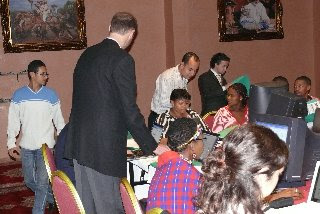Saturday, July 20, 2013
Saturday, January 3, 2009
Africa Climate Site
Who are minorities?
They are non-dominant ethnic, religious and linguistic communities, who may not necessarily be numerical minorities.
Most Forest-dwelling communities or pastrolists are minorities who are mostly indigenous people and are not effectively included in the Climate Change discussions. "Indigenous peoples have for centuries adapted to changing environments and would be able to contribute substantially to adaptation strategies the UN is trying to include in a new climate change treaty."
The impact of climate change hits indigenous and minority communities the hardest because they live in ecologically diverse areas and their livelihoods are dependent on the environment.
Inuits in the arctic are seeing people fall through melting ice, long droughts in east Africa are resulting in food shortages for pastoralists and Khmer Krom rice farmers in the Mekong delta in south Vietnam are seeing their crop yields fall.
Minorities are often amongst the poorest and most marginalised communities and are most likely to face discrimination when climate-related disasters occur, as is the experience of lower-caste Dalits in India.
"There has been a lot of attention paid to the damage climate change is doing to the environment and the loss of certain plant or animal species, but we aren't sufficiently recognizing the impact on people. There are entire communities that could be lost. Cultures, traditions and languages could be wiped off the earth".
Africa Climate Site
Climate
Most of Africa has a warm or hot climate, but the humidity and amount of rainfall vary dramatically from area to area.
Africa has the largest tropical area of any continent. The equator runs through the middle of Africa, and about 90 per cent of the continent lies within the tropics. In countries south of the equator, the seasons are opposite those of countries that lie north of the equator. But temperatures are high the year around almost everywhere in Africa. The variations between summer and winter temperatures are slight. In fact, the difference between daytime and nighttime temperatures in most parts of the continent is greater than the difference in the average temperatures between the coldest and warmest months. For this reason, some people say that nighttime is the "winter" of the tropics.
Africa's highest temperatures occur in the Sahara and in parts of Somalia. The highest temperature ever recorded in the world was 136 degrees F. (58 degrees C) in the shade at Al Aziziyah, Libya, on Sept. 13, 1922. At I-n-Salah, Algeria, and along the north coast of Somalia, July temperatures soar to 115 degrees F. (46 degrees C) or higher almost every day. Nighttime temperatures, however, may drop sharply. The Sahara also has the greatest seasonal range of temperatures in Africa. Winter temperatures in the Sahara average from 50 degrees to 60 degrees F. (10 degrees to 16 degrees C). Near the equator, temperatures may average 75 degrees F. (24 degrees C) or more the year around. But temperatures of more than 100 degrees F. (38 degrees C) are rare.
The coolest regions in Africa are the northwest, the highland areas of the east, and parts of the south. In Johannesburg, South Africa, for example, the average temperature in January, the warmest month, is 68 degrees F. (20 degrees C). Frost and snowfall are common in the mountains of Africa.
Sunday, November 16, 2008
Irrigable potential of Niger basin estimated at 2.8 million hectares
jeudi 13 novembre 2008
The potential of irrigation of the basin of the Niger River is estimated at 2.816 million hectares, a survey on the cultivation of rice released by the West African Bureau of the UN Economic Commission for Africa (ECA) made available to PANA on Wednesday said.
For Mali, the Office of Niger built in 1932 in the central delta of the river, covered a potential of around 1 million hectares out of hardly 150,000 hectares were exploited after more than seven decades, said the survey.
It noted that the objective of governments of the sub-region was to incorporate, as fast as possible, new dynamics of the cultivation of rice, taking into account the fact that the zone had abundant agricultural potentials.
Around 874 million hectares of Africa's land are considered as physically adapted to the agricultural production with the continent using only 4 per cent of this resource against 40 per cent for Asia, the document pointed out.
In the West African sub-region, the hydro resources estimated at 1,000 billion cubic meters of fresh water is renewed each year through the normal hydro cycle.
In spite of these assets, the study said in 2006, the countries of the Economic Community of West African States (ECOWAS) imported 7.2 million tonnes of rice, which was one-third of the world imports, at the cost of approximately US$ 1.7 billion.
The strong dependence on foreign countries in this field is a serious handicap on macro-economic stability in the West African sub-region.
Soaring prices of food products, in particular rice, over the first quarter of this year, triggered demonstrations in many of the countries of the sub-region.
Sub-regional rice consumption is in constant progression, approximately 9.6 per cent over the period 2001-2006.
The sub-regional production estimated at approximately 6.13 million tons in 2006 covered only 49 per cent of the sub-region's needs.
The principal rice producing countries of the sub-region are Nigeria, with 2.63 million tons, followed by Guinea with 898,000 tons, Sierra Leone with 711,000 tons and Mali with 682,000 tons.
Bamako - 12/11/2008





